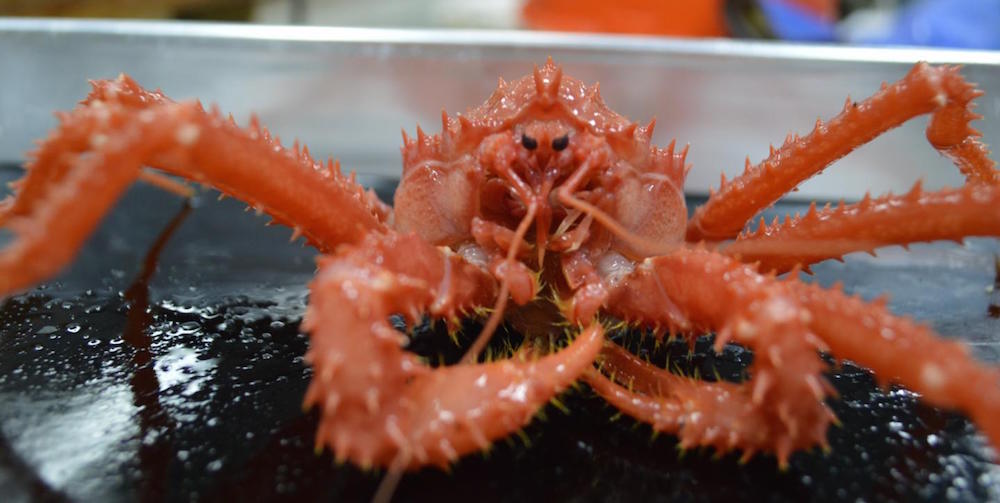King Crabs Arrive in Antarctic, with Claws Out for Biodiversity

The king crab could soon take over a whole new kingdom, and it has global warming to thank for the conquest.
King crabs live on seafloors all over the world (perhaps most famously off the Alaskan coast), but scientists didn't know that these large crustaceans had ventured all the way down to the frigid waters off Antarctica until recently. And now that the large crustaceans have arrived, they could seriously disrupt the thriving marine ecosystem off the Antarctic mainland, according to a new study.
Right now, king crabs inhabit the slope of Antarctica's continental shelf (the point where the shallow waters of the continental shelf give way to the deep sea). The crabs haven't yet made their way to the flat expanse of the shelf because the water there is just a tad too cold for them, said Richard Aronson, head of the department of biological studies at the Florida Institute of Technology and lead author of the new study on Antarctica's burgeoning king crab population. [See Images of King Crabs and Other Antarctic Seafloor Life]
But Antarctica's waters are getting warmer, Aronson told Live Science. Sometime within the next few decades, the continent's icy sea will have warmed enough (by about 1.8 degrees Fahrenheit, or 1 degree Celsius) to allow these giant crabs to climb up onto the shelf and start gobbling up the echinoderms (a group that includes sea stars and sea urchins) and mollusks (such as clams and mussels) that live there.
"That's what has got us concerned — that if they get up onto the continental shelf they will draw down those populations that have lived in isolation from these kind of predators for probably a very long time," Aronson said. The fossil record suggests that Antarctica's sea critters haven't had to contend with shell-crushing predators, such as crabs, for tens of millions of years, he added.
The introduction of king crabs to the Antarctic coast could also lead to an uptick in crab-eating predators in the area, Aronson noted. The Antarctic toothfish might come around to munch on the crabs, and certain species of seal (southern elephant seals, crab-eating seals) could also be drawn to the large crustaceans.
In a way, these predators will "re-modernize" Antarctica's marine community, said Aronson, who noted that the ocean floor off the continent's coast doesn't resemble that of any other seafloor on Earth today. Instead, it looks like most seafloors did about 40 million years ago, before the "fast-moving, bone-crushing modern predators, like fish and crabs," came around, he added.
Sign up for the Live Science daily newsletter now
Get the world’s most fascinating discoveries delivered straight to your inbox.
And higher water temperatures caused by climate change won't just make Antarctica's marine environment more modern, they'll also make this ecosystem less unique. With the introduction of the king crab and its predators, the continental shelf off Antarctica will look a lot more like the continental shelves at lower latitudes (farther north), according to the study researchers. [Antarctica and 7 Other Endangered Places in the World]
This might not seem like such a horrible prospect (does it really matter if two seafloors look the same?), but for biologists like Aronson, homogenization of the world's seafloors isn't a superfluous topic. The variation and "colorful differences" that are being exterminated by climate change and the introduction of invasive species into non-native environments is a real problem on land and at sea, Aronson said.
"In practical terms, one of the risks is potentially losing pharmaceuticals from the sea that we don't yet know about. It's a similar argument to that made for rainforests. It turns out there's a lot of animals in Antarctica that have these compounds in them that might have pharmaceutical value," Aronson said.
For example, researchers (including one of the study's co-authors, James McClintock, a professor of biology at the University of Alabama) are now investigating a sea squirt from Antarctica that shows anti-melanoma activity. These tiny marine creatures could potentially play a role in the development of life-saving cancer drugs, Aronson said.
But the reasons for wanting to preserve Antarctica's marine biodiversity go beyond the development of new drugs, according to Aronson, who said he tends to think of the loss of biodiversity in ethical and aesthetic terms.
"I feel like a lot of us believe that we need to be responsible stewards of the planet," he said. "Antarctica is unusual. It's a place that fires the imagination. To throw that away, to me, is a terrible thing."
The new study by Aronson and his colleagues was funded in part by the National Science Foundation and was published yesterday (Sept. 28) in the journal the Proceedings of the National Academy of Sciences.
Follow Elizabeth Palermo @techEpalermo. Follow Live Science @livescience, Facebook & Google+. Original article on Live Science.

Elizabeth is a former Live Science associate editor and current director of audience development at the Chamber of Commerce. She graduated with a bachelor of arts degree from George Washington University. Elizabeth has traveled throughout the Americas, studying political systems and indigenous cultures and teaching English to students of all ages.










